Input interpretation

arsine
Chemical names and formulas
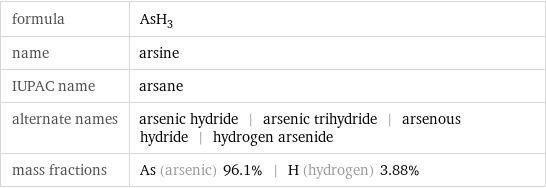
formula | AsH_3 name | arsine IUPAC name | arsane alternate names | arsenic hydride | arsenic trihydride | arsenous hydride | hydrogen arsenide mass fractions | As (arsenic) 96.1% | H (hydrogen) 3.88%
Lewis structure
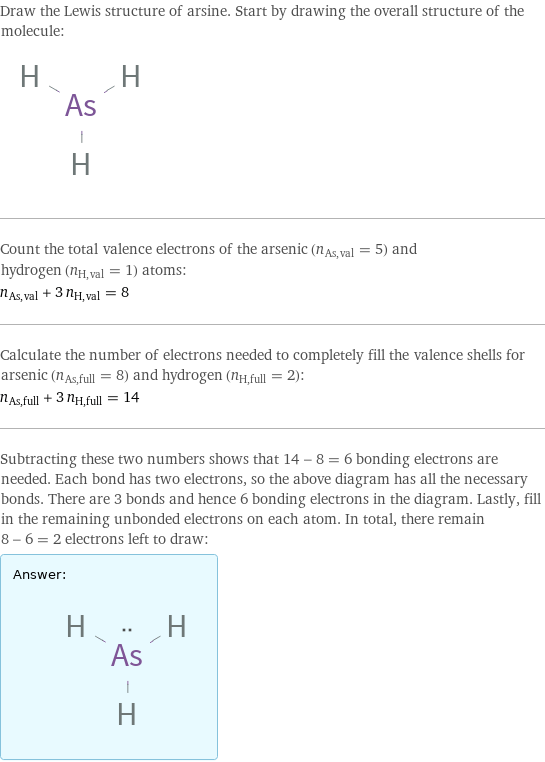
Draw the Lewis structure of arsine. Start by drawing the overall structure of the molecule: Count the total valence electrons of the arsenic (n_As, val = 5) and hydrogen (n_H, val = 1) atoms: n_As, val + 3 n_H, val = 8 Calculate the number of electrons needed to completely fill the valence shells for arsenic (n_As, full = 8) and hydrogen (n_H, full = 2): n_As, full + 3 n_H, full = 14 Subtracting these two numbers shows that 14 - 8 = 6 bonding electrons are needed. Each bond has two electrons, so the above diagram has all the necessary bonds. There are 3 bonds and hence 6 bonding electrons in the diagram. Lastly, fill in the remaining unbonded electrons on each atom. In total, there remain 8 - 6 = 2 electrons left to draw: Answer: | |
Basic properties
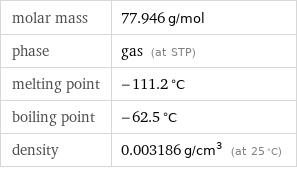
molar mass | 77.946 g/mol phase | gas (at STP) melting point | -111.2 °C boiling point | -62.5 °C density | 0.003186 g/cm^3 (at 25 °C)
Units

Gas properties (at STP)
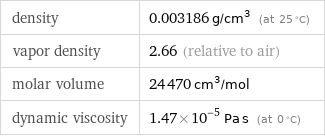
density | 0.003186 g/cm^3 (at 25 °C) vapor density | 2.66 (relative to air) molar volume | 24470 cm^3/mol dynamic viscosity | 1.47×10^-5 Pa s (at 0 °C)
Units

Thermodynamic properties
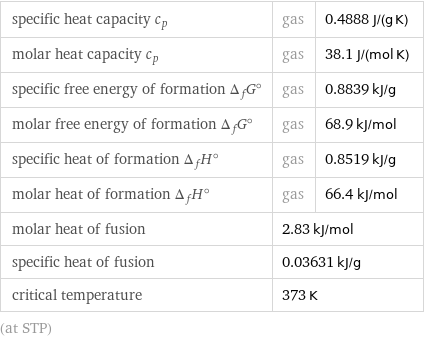
specific heat capacity c_p | gas | 0.4888 J/(g K) molar heat capacity c_p | gas | 38.1 J/(mol K) specific free energy of formation Δ_fG° | gas | 0.8839 kJ/g molar free energy of formation Δ_fG° | gas | 68.9 kJ/mol specific heat of formation Δ_fH° | gas | 0.8519 kJ/g molar heat of formation Δ_fH° | gas | 66.4 kJ/mol molar heat of fusion | 2.83 kJ/mol | specific heat of fusion | 0.03631 kJ/g | critical temperature | 373 K | (at STP)
Chemical identifiers
![CAS number | 7784-42-1 PubChem CID number | 23969 SMILES identifier | [AsH3] InChI identifier | InChI=1/AsH3/h1H3 EU number | 232-066-3 Gmelin number | 599 RTECS number | CG6475000](../image_source/c27343928feb500855a02fd09f9dc009.png)
CAS number | 7784-42-1 PubChem CID number | 23969 SMILES identifier | [AsH3] InChI identifier | InChI=1/AsH3/h1H3 EU number | 232-066-3 Gmelin number | 599 RTECS number | CG6475000
NFPA label

NFPA label
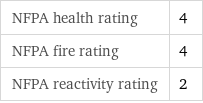
NFPA health rating | 4 NFPA fire rating | 4 NFPA reactivity rating | 2
Safety properties

flash point | -62 °C lower explosive limit | 4.5% (concentration in air) upper explosive limit | 78% (concentration in air)

DOT hazard class | 2.3 DOT numbers | 2188
Toxicity properties

long-term exposure limit | 0.2 mg/m^3 (over 8 hours) RTECS classes | tumorigen | human data
Units
